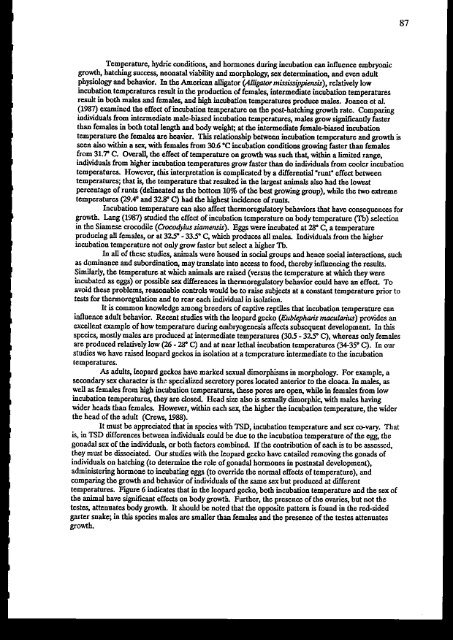size: 5036KB - Crocodile Specialist Group
size: 5036KB - Crocodile Specialist Group
size: 5036KB - Crocodile Specialist Group
You also want an ePaper? Increase the reach of your titles
YUMPU automatically turns print PDFs into web optimized ePapers that Google loves.
87<br />
TeEperature, hy&ic coaditionq aad hornoaas rlurilg ircubatior can inlluence eEbrroric<br />
g.owth, hatchiDg suc{res, neonatal viability ad morphologr, sex rleterminatio4 ajrd cven adult<br />
physiolog a.nd behavior. ID tlc America[ aligatof (/ligator nbsbsippienslt), relatir€ly low<br />
ircubation tedperatures result i[ &e produdior of female,s, btermediate ircubado! temperatues<br />
rcsult iD both malas ard femalas, ard high incubatior teBperatures producc m6lcs. Joaren et a.l.<br />
(1987) exanircd the ctrect ofincubatiotr tedperature or the post-hatching glowth rate. Comparirg<br />
individuals ion htermediate Eale-birs€d idcubatior tempcratureE malca grow signficadly fasfer<br />
tlajr femalas h both total leogth and body weiglq at the iatermediatc female-biascd iacubation<br />
teBperaturc the fcmales aro hcavie.. This relatiorship bctwe€n incubation tomperature alld gro*th is<br />
seetr 6lso *itlin a serg wit[ fcnalcs ftom 30.6 "C incubation conditioDs growiDg faster thar femdes<br />
fron 31.7 C. O!c.6ll, thc efiect of tempcraturc on groflth i'as such tlat, witlin a limired rote,<br />
individuals fion Ligher incubatior tempcraturcs grow faster thaD do individuals ftom cooler ircubation<br />
temperatue!. Howerc., tiit intcrpretatiotr G coDrplicated by a difrere ial .ru.ot cfiect betweetr<br />
teEpcratuos; thal4 the temp€Iatute that r€$lteal h tte larg€ar aainals also Lad the lo*€st<br />
p€rc€ntage of ruts (delineatcd as the bottoE 10% of tlc bast growing group), while the two erreEe<br />
tchpcraturqs (29.4' a.nd 32.8 C) had ilc highcst iacidelce of ruds.<br />
hcubatio! tempcratue ca! also alfecJ thermoregulatory behaviors that have consequodc€s for<br />
growth. lang (19&7) studied thc elfod of i.ncubatiotr tempclature on body tempelature (Tb) selecrion<br />
in the Sia$ese Gococlile (Oocodtlli sidmensis). Eggs *lle incubated at 28" c' a teDrperature<br />
producing aI feEales, or at 32.t - 35" c, which Foduces all Eales. Individuals fron rtc higher<br />
iocubatior teEperature not ooly grow faster but select a higher Tb.<br />
In all of these studiixs, admals were Loused in social groups ad hencr social htenctions, such<br />
a5 domi&rce a.nd subordi&tioo, Eay traDslate ilto acc€ss to foo4 thereby influercing the rasults.<br />
Similady, thc tcDrpcnturc at wLictr animals are rais€d (versrB thc tomp€raturc at which they werE<br />
iacubatcd as eggs) or possible s€x differcnccs ilr thermoregulalory behavior could have ar effect. To<br />
avoid thesc problcms, reasoiabl€ controls would bc !o rairc 6ubjects at a constant teEperaturc prior to<br />
tesB for thermoregdlation aid to rcar e3ch bdividul in isolation.<br />
It is coBEor laowledge amoog breeders of capti!€ reptiles that ircubation temp€raturc can<br />
iolluencc adult b€havior. Recelt studies with tLe leopard ge.ko (Eublepholit macaran'6) provides sn<br />
excelled example of how tempefthuc duling embryogene.sis affects subs€quent developEeDt. In lhis<br />
specieE Eosdy males are produc€d at futemediatc teEperaturcs (305 - 35. C), whereas only females<br />
arc produced relativcly low ( - zA Q ai at rcar lethd incubatioo tcmperatures (3435. C). In our<br />
studigs we have raised leopard geckos i! isolatioD at a temp€.atuie idtermediate to the i.ncubation<br />
teEpcratrues.<br />
As adults, leopard gectos hare marked scxual dimorphisms i.n morphologf. For c)(ampL, a<br />
secondaty s€x ctraracter is thc spccializ€d secretory porcs loqtod arterior to ttc cloa@. Iu Ealcs, as<br />
well as feEales from high incubation temperatues, thesc pores are opeo, while iD fedales ftom low<br />
hcubatio! temperatures, tley are closed Head <strong>size</strong> also is s€xually dinorphiq rritl males having<br />
widcr heads tha.u females. However, wit[in each sex, tLe higher the incubatiotr temperaturo, tle wider<br />
the head of thc adult (Crew\ 1988)<br />
It must be approciated that in spccies witl TS4 incubatior tcmperaturc atrd sex co-vary. That<br />
is, in TSD rliflereuces between individuals coutd be duc to the incubatio! te&perature of the cg& the<br />
gonadal sex of the individual$ or both factors combined. If the contribution of each is to be asssssed,<br />
they mtlst be dissociated. Our studies with the leopard gecko Lave entailed removiDg the goaads of<br />
individuals ou hatchiry (to determire tho role ofgonadal horDrones ir poshatal development),<br />
admiDisteritrg honuonc to ircubating eggs (to overide the Ilorma.l effecG of tcmpcranrre), atrd<br />
compariag tie growth ard behavior of individuals of the saee sex but produced at different<br />
temperatures. Figurc 6 indic{te,s that b t[e leopard gecko, both iacubatioa teEpcrature ard the sex of<br />
&e animal havc sigdifica.d effcds on body growtL Further, the presenc€ of the ovaries, but lrot tle<br />
test€S attenuates body gro*tb" It should bc noted tbat tle opposite pattern is found ia the red-sided<br />
garter sDalq itr this species males are staller thar fcmales an
















